 |
 |
09.04.14

Why Reframing is Important to Great Leadership
LEADERS need to be able to look at the situations they face from different perspectives. The need to be able to reframe a situation in order to understand what it really going on and deal with it effectively. A leader’s “ability to reframe sets them free” and helps them to “avoid getting trapped in cognitive ruts,” write Lee Bolman and Terrence Deal, authors of How Great Leaders Think. “Leaders can expand how they think by using different mental models to determine what’s going on and what to do in complex situations.”Bolman and Deal are the authors of Reframing Organizations. They have taken the model they introduced there and applied it specifically to leadership. The model has four frames, scripts, or perspectives. Each has its advantages and shortcomings and we tend to lean towards one more than the others. This idea, of course, is to develop the ability to use the appropriate frame or script to generate a unique approach to handling challenging circumstances instead of relying upon our tried and true default approaches. Our single approach will only be “right” a small percentage of the time. Too often leaders will approach everything they deal with the last approach and insist they are right as they head right over the cliff. They insist that the world is as they see it. To grow is to recognize your blind spots. The four frames are: Structural — Leader’s role as architect. An emphasis on finding the right design for the task at hand. Structural leaders help groups get clear about why they’re there, who is in charge, who is supposed to do what, and how team members can work with on another to achieve the group’s purpose. Human Resources — Leader’s role as coach. The central theme is improving the fit between the individual and the organization and begins with caring—or in a word, love. Leaders who commit themselves to key practices of effective people leadership—developing a philosophy for managing people, hiring the right people, keeping employee investing in their future, empowering them, and promoting diversity—have repeatedly built businesses that thrive on the strength of employee talent, energy, and creativity. Political — Leader’s role as peacemaker. Organizations and societies are networks as well as hierarchies, and the power of relationships is a crucial complement to the power of position. Misreading the political map and overlooking the power of potential players can lead to catastrophe. That’s why it’s critical to treat the map as a work in progress—a guide to be tested as you move along. Symbolic — Leader’s role as storyteller. The central theme is the way humans discover and create meaning in an ambiguous and chaotic world. Symbolic leadership begins with the leader’s deeply rooted faith and passion. Symbolic leaders infuse magic into organizations through their artistic focus on history, shared values, heroes, ritual, ceremony, and stories, and serve as icons who embody a group’s values and spirit. The authors write: “Consciously or not, we all read situations to figure out what scene we’re in and what role we’ve been assigned so that we can respond in character. But it’s important to ask ourselves whether the drama is the one we want and recognize that we have latitude as to which character to play and how to interpret the script.” The authors provide practical lessons from examining these frames through the leadership of Jeff Bezos, Howard Schultz, Tony Hsieh, Ursala Burns, Steve Jobs, and others. 
Posted by Michael McKinney at 07:51 PM
|
BUILD YOUR KNOWLEDGE
 

How to Do Your Start-Up Right STRAIGHT TALK FOR START-UPS 
Grow Your Leadership Skills NEW AND UPCOMING LEADERSHIP BOOKS 
Leadership Minute BITE-SIZE CONCEPTS YOU CAN CHEW ON 
Classic Leadership Books BOOKS TO READ BEFORE YOU LEAD |